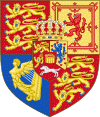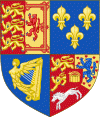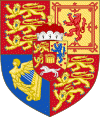|
1. From 1760 until 1801 (first period) The Elector of Hanover inherited the throne following death of Queen Anne under the provisions of the Act of Settlement 1701, becoming King George III. The fourth quarter of the arms was changed to reflect the new King’s domains in Hanover (Brunswick—Luneburg—Westphalia, surmounted by the Imperial Crown of the Holy Roman Empire for the Holy Roman office of Archbannerbearer/Archtreasurer). |
Arms. 1. England impaling Scotland; 2. France Modern; 3. Ireland; 4. Hanover. Hanover: Tierced in pairle reversed [per pale and per chevron]: 1. Brunswick. Gules two lions passant guardant in pale Or armed and langued Azure; 2. Luneberg. Or semé of hearts Gules a lion rampant Azure armed and langued Gules; 3. Westphalia. Gules a horse courant Argent; and over all an inescutcheon Gules charged with the golden Crown of Charlemagne |
|
|
2. From 1801 to 1816 (second period) Act of Union 1800 between the Kingdom of Great Britain and the Kingdom of Ireland. The claim to the French throne continued, albeit passively, until it was mooted by the French Revolution and the formation of the French First Republic in 1792. During the peace negotiations at the Conference of Lille, from July to November 1797, the French delegates demanded that the King of Great Britain abandon the title of King of France as a condition of peace. The Acts of Union 1800 united the Kingdom of Great Britain with the Kingdom of Ireland to form the United Kingdom of Great Britain and Ireland. Under King George III of the United Kingdom, a proclamation of 1 January 1801 set the royal style and titles and modified the Royal Arms, removing the French quarter and putting the arms of England, Scotland and Ireland on the same structural level, with the dynastic arms of Hanover moved to an inescutcheon. |
Quarterly: 1 and 4.England; 2. Scotland; 3. Ireland. On an inescutcheon of pretence the arms of Hanover surmounted by a elector’s bonnet. |
|
|
3. From 1816 to 1820 (third period) Following Prime Minister Spencer Perceval’s assassination in 1812, he was replaced by Lord Liverpool, who oversaw British victory in the Napoleonic Wars. The subsequent Congress of Vienna led to significant territorial gains for Hanover, which was upgraded from an electorate to a kingdom. |
As for earlier (1800 onwards) with the Elector’s bonnet replaced by the Crown of what was now the Kingdom of Hanover. |
 |
|
Illustrations of coats of arms by courtesy of Wikimedia Commons. |
|
|
| © Goathland PCC 2012 |

